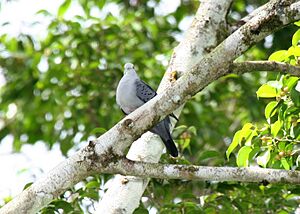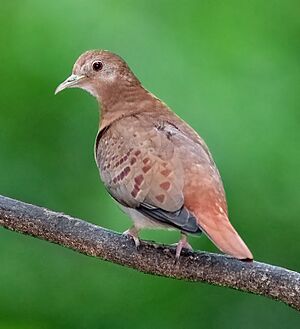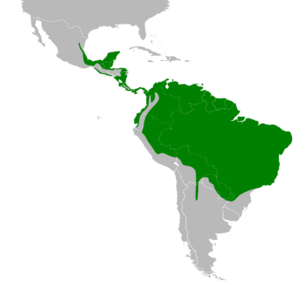Blue ground dove facts for kids
Quick facts for kids Blue ground dove |
|
|---|---|
 |
|
| male | |
 |
|
| female | |
| Conservation status | |
| Scientific classification | |
| Genus: |
Claravis
|
| Species: |
pretiosa
|
 |
|
The blue ground dove (Claravis pretiosa) is a small New World tropical dove. It lives and raises its young from southeastern Mexico all the way to northwestern Peru and northern Argentina. You can also find it on the island of Trinidad in the Caribbean.
Contents
Where They Live and How They Raise Young
You can often find the blue ground dove in open woodlands and along the edges of forests. They also like clearings and roadsides, especially in places that are more humid. These doves live from sea level up to about 1200 meters high.
Blue ground doves build a simple, dish-shaped nest using twigs. They place these nests in trees, usually between 1 and 11 meters off the ground. Each time, the female dove lays two white eggs.
What They Look Like
Blue ground doves are small pigeons. They are about 20 centimeters (8 inches) long and weigh around 65 to 72 grams (2.3 to 2.5 ounces).
Males
Adult male blue ground doves have blue-grey feathers on their upper bodies. Their undersides are a lighter grey, turning almost white on their faces. Their flight feathers and outer tail feathers are blackish. Their wings have bold black spots, which often form clear bands. They have red or yellow eyes, and a green ring around their eyes. Their legs are a pinkish color.
Females
Female blue ground doves look a bit different. Their heads, necks, and chests are grey-brown. Their underwings and bellies are a pale blue-grey. Their backs are a reddish-brown, which stands out against their chestnut-colored rump and tail. The spots on their wings are chestnut-brown.
Young Doves
Young blue ground doves look similar to the females. However, they have reddish, scale-like patterns on their backs.
How to Tell Them Apart
In most places, it's easy to spot a male blue ground dove. There aren't many other birds that look quite like them. Females can sometimes be confused with other doves, like the female ruddy ground dove. But ruddy ground doves are smaller and have blackish wing markings instead of chestnut-brown ones. If you see a blue-grey bird and a brown bird flying together through the trees, it's probably a pair of blue ground doves!
What They Eat and How They Behave
Blue ground doves can be seen alone, in pairs, or sometimes in small groups. They mostly look for food on the ground. Their diet mainly consists of seeds and small insects. They also eat small pieces of grit, which helps them digest their food.
When a male blue ground dove sings, it usually does so from the top of a tree. Its song is a loud "boop" sound.
About Their Name
The scientific name for the blue ground dove is Claravis pretiosa. The name Claravis was given by an American bird expert named Harry C. Oberholser in 1899. It comes from two Latin words: clarus, which means "distinct" or "clear," and avis, which means "bird." So, Claravis basically means "distinct bird."


